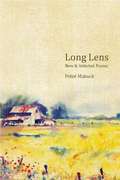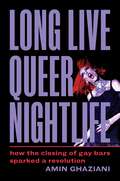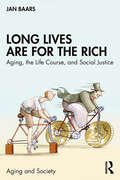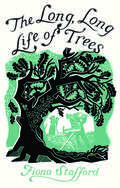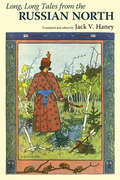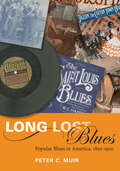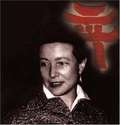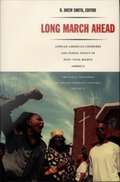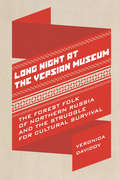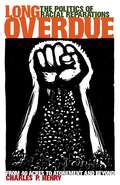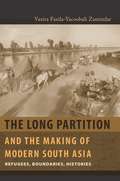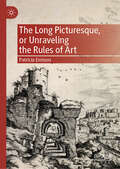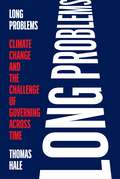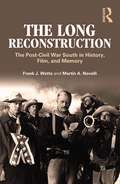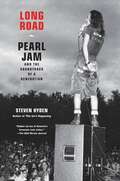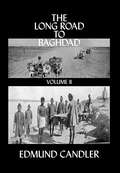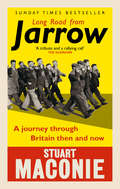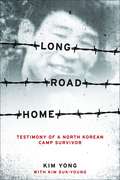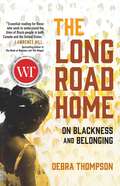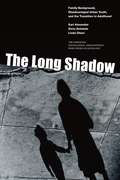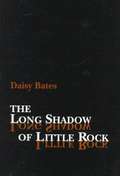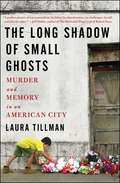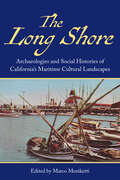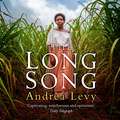- Table View
- List View
Long Lens
by Peter Makuck"Peter Makuck sees through the detritus of daily life to what matters. . . . It's that essence that lives deep down in things, looked for in people, sea- and landscapes, and creatures, that lifts the quotidian toward the marvelous, and animates this selection of poems from four decades."--Brendan GalvinFrom "Long Lens":Folding laundry, I can see our clotheslinewaving its patches of color like the flagof a foreign country where I had happily livedin a small clapboard house surrounded by pines.I can hear my mother in her strong accentsaying she didn't want a dryereven when we could finally afford one--Our sheets won't smell of trees and sunlight anymore.Long Lens represents forty years of Peter Makuck's work, including twenty-five new poems. With precise language, Makuck's imagery evokes spiritual longing, love, loss, violence, and transcendence. His subjects include the aftermath of the 1970 killings at Kent State University; scuba diving on an offshore shipwreck; flying through a storm in a small plane; rescuing a boy caught in a riptide; and lucid observations of spinner sharks, a gray fox, a spider, and a pelican tangled in a fishing line.Peter Makuck taught at East Carolina University from 1976 to 2006, where he founded Tar River Poetry. He was 2008 Lee Smith Chair in Creative Writing at North Carolina State University. Winner of the Brockman Award and the Charity Randall Citation, he lives on Bogue Banks, one of North Carolina's barrier islands.
Long Live Queer Nightlife: How the Closing of Gay Bars Sparked a Revolution
by Amin GhazianiIt&’s closing time for an alarming number of gay bars in cities around the globe—but it&’s definitely not the last danceIn this exhilarating journey into underground parties, pulsating with life and limitless possibility, acclaimed author Amin Ghaziani unveils the unexpected revolution revitalizing urban nightlife.Far from the gay bar with its largely white, gay male clientele, here is a dazzling scene of secret parties—club nights—wherein culture creatives, many of whom are queer, trans, and racial minorities, reclaim the night in the name of those too long left out. Episodic, nomadic, and radically inclusive, club nights are refashioning queer nightlife in boundlessly imaginative and powerfully defiant ways.Drawing on Ghaziani&’s immersive encounters at underground parties in London and more than one hundred riveting interviews with everyone from bar owners to party producers, revelers to rabble-rousers, Long Live Queer Nightlife showcases a spectacular, if seldom-seen, vision of a queer world shimmering with self-empowerment, inventiveness, and joy.
Long Lives Are for the Rich: Aging, the Life Course, and Social Justice (Aging and Society)
by Jan BaarsLong Lives Are for the Rich is the title of a silent ominous program that affects the lives of millions of people. In all developed countries disadvantaged and, especially, poor people die much earlier than the most advantaged. During these shorter lives they suffer ten to twenty years longer from disabilities or chronic disease. This does not happen accidentally: health inequalities – including those between healthy and unhealthy life styles – are mainly caused by social inequalities that are reproduced over the life course. This crucial function of the life course has become painfully visible during its neoliberal reorganization since the early 1980s. Studies about aging over the life course, from birth to death, show the inhumane consequences as people get older. In spite of the enormous wealth that has been piled up in the US for a dwindling percentage of the population, there has been growing public indifference about the needs of those in jobs with low pay and high stress, but also about citizens from a broad middle class who can hardly afford high quality education or healthcare. However, this ominous program affects all: recent mortality rates show that all Americans, including the rich, are unhealthier and dying earlier than citizens of other developed countries. Moreover, the underlying social inequalities are tearing the population apart with nasty consequences for all citizens, including the rich. Although the public awareness of the consequences has been growing, neoliberal policies remain tempting for the economic and political elites of the developed world because of the enormous wealth that is flowing to the top. All this poses urgent questions of social justice. Unfortunately, the predominant studies of social justice along the life course help to reproduce these inequalities by neglecting them. This book analyzes the main dynamics of social inequality over the life course and proposes a theory of social justice that sketches a way forward for a country that is willing to invest in its greatest resource: the creative potential of its population.
Long Lives Are for the Rich: Aging, the Life Course, and Social Justice (ISSN)
by Jan BaarsLong Lives Are for the Rich is the title of a silent ominous program that affects the lives of millions of people. In all developed countries disadvantaged and, especially, poor people die much earlier than the most advantaged. During these shorter lives they suffer ten to twenty years longer from disabilities or chronic disease. This does not happen accidentally: health inequalities – including those between healthy and unhealthy life styles – are mainly caused by social inequalities that are reproduced over the life course. This crucial function of the life course has become painfully visible during its neoliberal reorganization since the early 1980s. Studies about aging over the life course, from birth to death, show the inhumane consequences as people get older. In spite of the enormous wealth that has been piled up in the US for a dwindling percentage of the population, there has been growing public indifference about the needs of those in jobs with low pay and high stress, but also about citizens from a broad middle class who can hardly afford high quality education or healthcare. However, this ominous program affects all: recent mortality rates show that all Americans, including the rich, are unhealthier and dying earlier than citizens of other developed countries. Moreover, the underlying social inequalities are tearing the population apart with nasty consequences for all citizens, including the rich. Although the public awareness of the consequences has been growing, neoliberal policies remain tempting for the economic and political elites of the developed world because of the enormous wealth that is flowing to the top. All this poses urgent questions of social justice. Unfortunately, the predominant studies of social justice along the life course help to reproduce these inequalities by neglecting them. This book analyzes the main dynamics of social inequality over the life course and proposes a theory of social justice that sketches a way forward for a country that is willing to invest in its greatest resource: the creative potential of its population.
The Long, Long Life of Trees
by Fiona StaffordA lyrical tribute to the diversity of trees, their physical beauty, their special characteristics and uses, and their ever-evolving meanings Since the beginnings of history trees have served humankind in countless useful ways, but our relationship with trees has many dimensions beyond mere practicality. Trees are so entwined with human experience that diverse species have inspired their own stories, myths, songs, poems, paintings, and spiritual meanings. Some have achieved status as religious, cultural, or national symbols. In this beautifully illustrated volume Fiona Stafford offers intimate, detailed explorations of seventeen common trees, from ash and apple to pine, oak, cypress, and willow. The author also pays homage to particular trees, such as the fabled Ankerwyke Yew, under which Henry VIII courted Anne Boleyn, and the spectacular cherry trees of Washington, D. C. Stafford discusses practical uses of wood past and present, tree diseases and environmental threats, and trees' potential contributions toward slowing global climate change. Brimming with unusual topics and intriguing facts, this book celebrates trees and their long, long lives as our inspiring and beloved natural companions.
Long, Long Tales from the Russian North
by Jack V. HaneyThis volume of folktales from the Far North of European Russia features seventeen works by five narrators of the Russian tale, all recorded in the twentieth century. The tales, distinguished by their extraordinary length and by the manner in which they were commonly told, appear to have flourished only in the twentieth century and only in Russian Karelia. Although the tales are easily recognized as wondertales, or fairy tales, their treatment of the traditional matter is anything but usual. In these tales one encounters such topics as regicide, matricide, patricide, fratricide, premarital relations between the sexes and more, all related in the typical manner of the Russian folktale. The narrators were not educated beyond a rudimentary level. All were middle-aged or older, and all were men. Crew members of a fishing or hunting vessel plying the White Sea or lumberjacks or trappers in the vast northern forests, they frequently began the narration of a tale in an evening, then broke off at an appropriate moment and continued at a subsequent gathering. Such tales were thus told serially. Given their length, their thematic and narrative complexity, and their stylistic proficiency, one might even refer to them as orally delivered Russian short stories or novellas.
Long Lost Blues: Popular Blues in America, 1850-1920 (Music in American Life)
by Peter C. MuirMamie Smith's 1920 recording of ""Crazy Blues"" is commonly thought to signify the beginning of commercial attention to blues music and culture, but by that year more than 450 other blues titles had already appeared in sheet music and on recordings. In this examination of early popular blues, Peter C. Muir traces the genre's early history and the highly creative interplay between folk and popular forms, focusing especially on the roles W. C. Handy played in both blues music and the music business. Long Lost Blues exposes for the first time the full scope and importance of early popular blues to mainstream American culture in the early twentieth century. Closely analyzing sheet music and other print sources that have previously gone unexamined, Muir revises our understanding of the evolution and sociology of blues at its inception.
The Long March: An Account of Modern China
by Simone De Beauvoir Austryn WainhouseAuthor of "The Second Sex", and one of the 20th century's most brilliant writers, Simone de Beauvoir turns her attention eastward to China and paints a masterly picture of that nation in modern times. Honest and detailed, it comes from de Beauvoir's personal journey through the country: "I have tried to evaluate all the knowledge gained at first-hand, by actually seeing places and talking with people", she said, poignantly, noting how the Chinese "are fighting hard to build a human world".
Long March Ahead: African American Churches and Public Policy in Post-Civil Rights America
by R. Drew SmithAnalyzing the extensive data gathered by the Public Influences of African American Churches project, which surveyed nearly two thousand churches across the country, Long March Ahead assesses the public policy activism of black churches since the civil rights movement. Social scientists and clergy consider the churches' work on a range of policy matters over the past four decades: affirmative action, welfare reform, health care, women's rights, education, and anti-apartheid activism. Some essays consider advocacy trends broadly. Others focus on specific cases, such as the role of African American churches in defeating the "One Florida" plan to end affirmative action in college admissions and state contracting or the partnership forged between police and inner-city black ministers to reduce crime in Boston during the 1990s. Long March Ahead emphasizes the need for African American churches to complement the excellent work they do in implementing policies set by others by getting more involved in shaping public policy. The contributors explore the efficacy of different means of public policy advocacy and social service delivery, including faith-based initiatives. At the same time, they draw attention to trends that have constrained political involvement by African American churches: the increased professionalization of policy advocacy and lobbying, the underdevelopment of church organizational structures devoted to policy work, and tensions between religious imperatives and political activism. Long March Ahead takes an important look at the political role of African American churches after the great policy achievements of the civil rights era. Contributors Cathy J. Cohen Megan McLaughlin Columba Aham Nnorum Michael Leo Owens Desiree Pedescleaux Barbara D. Savage R. Drew Smith Emilie Townes Christopher Winship
Long Night at the Vepsian Museum: The Forest Folk of Northern Russia and the Struggle for Cultural Survival
by Veronica DavidovThis book takes readers to the village of Sheltozero in northern Russia. It highlights a tiny community of indigenous people called Veps, known colloquially as "the forest folk" for their intense closeness and affiliation with the forests in their ancestral territories. Davidov uses a tour of the local museum to introduce a cast of human and non-human characters from traditional Vepsian culture, while journeying through various eras under Russian, Finnish, Soviet, and post-Soviet rule. In the process, she explores how contemporary political struggles mesh with traditional beliefs, illustrating how Veps make meaning of their history and unfolding future. A documentary entitled Museum Night is available for instructors who wish to incorporate it into their teaching.
Long Overdue: The Politics of Racial Reparations
by Charles P. HenryAn investigation of America’s failure to atone for the wrongs of slaveryEver since the unfulfilled promise of “forty acres and a mule” after the Civil War, America has consistently failed to compensate Black Americans for the wrongs of slavery. Exploring why America has struggled to confront the issue of racial injustice, Long Overdue provides a history of the racial reparations movement and shows why it is more relevant now than ever.Through an examination of Americans’ unwillingness to address economic injustice, Charles P. Henry crafts a skillful moral, political, economic, and historical argument for African American reparations, focusing on successful political cases. In the wake of successes in South Africa and New Zealand, new models for reparations have found traction in a number of American cities and states, from Dallas to Baltimore and Virginia to California. By looking at other dispossessed groups—Native Americans, Holocaust survivors, and Japanese internment victims in the 1940s—Henry shows how some groups have won the fight for reparations, and explores new ways forward for Black Americans. From Hurricane Katrina to Hurricane Harvey, the events of the 21st century continue to show that the legacy of racial segregation and economic disadvantage is never far below the surface in America. As the issue of reparations is brought to the national stage by figures such as Ta-Nehisi Coates and Kamala Harris, Long Overdue provides a must-read survey of the political and legislative efforts made toward reparations over the course of American history, and offers a new path toward establishing equality for all Black Americans.
The Long Partition and the Making of Modern South Asia: Refugees, Boundaries, Histories (Cultures of History)
by Vazira Fazila-Yacoobali ZamindarNation-states often shape the boundaries of historical enquiry, and thus silence the very histories that have sutured nations to territorial states. "India" and "Pakistan" were drawn onto maps in the midst of Partition's genocidal violence and one of the largest displacements of people in the twentieth century. Yet this historical specificity of decolonization on the very making of a nationalized cartography of modern South Asia has largely gone unexamined. In this remarkable study based on more than two years of ethnographic and archival research, Vazira Fazila-Yacoobali Zamindar argues that the combined interventions of the two postcolonial states were enormously important in shaping these massive displacements. She examines the long, contentious, and ambivalent process of drawing political boundaries and making distinct nation-states in the midst of this historic chaos.Zamindar crosses political and conceptual boundaries to bring together oral histories with north Indian Muslim families divided between the two cities of Delhi and Karachi with extensive archival research in previously unexamined Urdu newspapers and government records of India and Pakistan. She juxtaposes the experiences of ordinary people against the bureaucratic interventions of both postcolonial states to manage and control refugees and administer refugee property. As a result, she reveals the surprising history of the making of the western Indo-Pak border, one of the most highly surveillanced in the world, which came to be instituted in response to this refugee crisis, in order to construct national difference where it was the most blurred.In particular, Zamindar examines the "Muslim question" at the heart of Partition. From the margins and silences of national histories, she draws out the resistance, bewilderment, and marginalization of north Indian Muslims as they came to be pushed out and divided by both emergent nation-states. It is here that Zamindar asks us to stretch our understanding of "Partition violence" to include this long, and in some sense ongoing, bureaucratic violence of postcolonial nationhood, and to place Partition at the heart of a twentieth century of border-making and nation-state formation.
The Long Picturesque, or Unraveling the Rules of Art
by Patricia EmisonThis book provides a Renaissance art historian’s view of how the picturesque aesthetic developed from roots in the sixteenth century (mostly in painting, but with ramifications for printmaking, landscape design, and architecture), and further, how the picturesque aesthetic fundamentally changed the relationship between art and nature, between viewer and image. The book's argument is based on wide reading of obscure yet piquant critical texts, mostly of the seventeenth and eighteenth centuries, together with consideration of varied works of art, ranging from Fra Angelico to Raphael and Michelangelo, and from Rubens to Canaletto, and from James Gibbs to Jacques Demy, all of them studied not for their place in the history of style, but for their spatial imagination.
Long Problems: Climate Change and the Challenge of Governing across Time
by Thomas HalePolitical strategies for tackling climate change and other &“long problems&” that span generationsClimate change and its consequences unfold over many generations. Past emissions affect our climate today, just as our actions shape the climate of tomorrow, while the effects of global warming will last thousands of years. Yet the priorities of the present dominate our climate policy and the politics surrounding it. Even the social science that attempts to frame the problem does not theorize time effectively. In this pathbreaking book, Thomas Hale examines the politics of climate change and other &“long problems.&” He shows why we find it hard to act before a problem&’s effects are felt, why our future interests carry little weight in current debates, and why our institutions struggle to balance durability and adaptability. With long-term goals in mind, he outlines strategies for tilting the politics and policies of climate change toward better outcomes.Globalization &“widened&” political problems across national boundaries and changed our understanding of politics and governance. Hale argues that we must make a similar shift to understand the &“lengthening&” of problems across time. He describes tools and strategies that can, under certain conditions, allow policymakers to anticipate future needs and risks, make interventions that get ahead of problems, shift time horizons, adapt to changing circumstances, and set forward-looking goals that endure. As the climate changes, politics must, too. Efforts to solve long-term problems—not only climate change but other issues as well, including technology governance and demographic shifts—can also be a catalyst for a broader institutional transformation oriented toward the long term. With Long Problems, Hale offers an essential guide to governing across time.
The Long Reconstruction: The Post-Civil War South in History, Film, and Memory
by Frank J. Wetta Martin A. NovelliA century and a half after the Civil War, Americans are still dealing with the legacies of the conflict and Reconstruction, including the many myths and legends spawned by these events. The Long Reconstruction: The Post-Civil War South in History, Film, and Memory brings together history and popular culture to explore how the events of this era have been remembered. Looking at popular cinema across the last hundred years, The Long Reconstruction uncovers central themes in the history of Reconstruction, including violence and terrorism; the experiences of African Americans and those of women and children; the Lost Cause ideology; and the economic reconstruction of the American South. Analyzing influential films such as The Birth of a Nation and Gone with the Wind, as well as more recent efforts such as Cold Mountain and Lincoln, the authors show how the myths surrounding Reconstruction have impacted American culture. This engaging book is essential reading for anyone interested in the history of Reconstruction, historical memory, and popular culture.
Long Road: Pearl Jam and the Soundtrack of a Generation
by Steven HydenA leading music journalist&’s riveting chronicle of how beloved band Pearl Jam shaped the times, and how their legacy and longevity have transcended generations. Ever since Pearl Jam first blasted onto the Seattle grunge scene three decades ago with their debut album, Ten, they have sold 85M+ albums, performed for hundreds of thousands of fans around the world, and have even been inducted into the Rock and Roll Hall of Fame. In Long Road: Pearl Jam and the Soundtrack Of A Generation, music critic and journalist Steven Hyden celebrates the life, career, and music of this legendary group, widely considered to be one of the greatest American rock bands of all time. Long Road is structured like a mix tape, using 18 different Pearl Jam classics as starting points for telling a mix of personal and universal stories. Each chapter tells the tale of this great band — how they got to where they are, what drove them to greatness, and why it matters now. Much like the generation it emerged from, Pearl Jam is a mass of contradictions. They were an enormously successful mainstream rock band who felt deeply uncomfortable with the pursuit of capitalistic spoils. They were progressive activists who spoke in favor of abortion rights and against the Ticketmaster monopoly, and yet they epitomized the sound of traditional, male-dominated rock &‘n&’ roll. They were looked at as spokesmen for their generation, even though they ultimately projected profound confusion and alienation. They triumphed, and failed, in equal doses — the quintessential Gen-X tale. Impressive as their stats, accolades, and longevity may be, Hyden also argues that Pearl Jam&’s most definitive accomplishment lies in the impact their music had on Generation X as a whole. Pearl Jam&’s music helped an entire generation of listeners connect with the glory of bygone rock mythology, and made it relevant during a period in which tremendous American economic prosperity belied a darkness at the heart of American youth. More than just a chronicle of the band&’s career, this book is also a story about Gen- X itself, who like Pearl Jam came from angsty, outspoken roots and then evolved into an establishment institution, without ever fully shaking off their uncertain, outsider past. For so many Gen-Xers growing up at the time, Pearl Jam&’s music was a beacon that offered both solace and guidance. They taught an entire generation how to grow up without losing the purest and most essential parts of themselves. Written with his celebrated blend of personal memoir, criticism, and journalism, Hyden explores Pearl Jam&’s path from Ten to now. It's a chance for new fans and old fans alike to geek out over Pearl Jam minutia—the B-sides, the beloved deep cuts, the concert bootlegs—and explore the multitude of reasons why Pearl Jam&’s music resonated with so many people. As Hyden explains, &“Most songs pass through our lives and are swiftly forgotten. But Pearl Jam is forever.&”
Long Road Baghdad: Volume 2
by CandlerFirst published in 2006. Routledge is an imprint of Taylor & Francis, an informa company.
Long Road from Jarrow: A journey through Britain then and now
by Stuart MaconieThe Sunday Times Bestseller'A tribute and a rallying call' - GuardianThree and half weeks. Three hundred miles. I saw roaring arterial highway and silent lanes, candlelit cathedrals and angry men in bad pubs. The Britain of 1936 was a land of beef paste sandwiches and drill halls. Now we are nation of vaping and nail salons, pulled pork and salted caramel.In the autumn of 1936, some 200 men from the Tyneside town of Jarrow marched 300 miles to London in protest against the destruction of their towns and industries. Precisely 80 years on, Stuart Maconie, walks from north to south retracing the route of the emblematic Jarrow Crusade. Travelling down the country’s spine, Maconie moves through a land that is, in some ways, very much the same as the England of the 30s with its political turbulence, austerity, north/south divide, food banks and of course, football mania. Yet in other ways, it is completely unrecognisable. Maconie visits the great cities as well as the sleepy hamlets, quiet lanes and roaring motorways. He meets those with stories to tell and whose voices build a funny, complex and entertaining tale of Britain, then and now.
Long Road Home: Testimony of a North Korean Camp Survivor
by Yong KimKim Yong shares his harrowing account of life in a labor camp-a singularly despairing form of torture carried out by the secret state. Although it is known that gulags exist in North Korea, little information is available about their organization and conduct, for prisoners rarely escape both incarceration and the country alive. Long Road Home shares the remarkable story of one such survivor, a former military official who spent six years in a gulag and experienced firsthand the brutality of an unconscionable regime. As a lieutenant colonel in the North Korean army, Kim Yong enjoyed unprecedented privilege in a society that closely monitored its citizens. He owned an imported car and drove it freely throughout the country. He also encountered corruption at all levels, whether among party officials or Japanese trade partners, and took note of the illicit benefits that were awarded to some and cruelly denied to others. When accusations of treason stripped Kim Yong of his position, the loose distinction between those who prosper and those who suffer under Kim Jong-il became painfully clear. Kim Yong was thrown into a world of violence and terror, condemned to camp No. 14 in Hamkyeong province, North Korea's most notorious labor camp. As he worked a constant shift 2,400 feet underground, daylight became Kim's new luxury; as the months wore on, he became intimately acquainted with political prisoners, subhuman camp guards, and an apocalyptic famine that killed millions. After years of meticulous planning, and with the help of old friends, Kim escaped and came to the United States via China, Mongolia, and South Korea. Presented here for the first time in its entirety, his story not only testifies to the atrocities being committed behind North Korea's wall of silence but also illuminates the daily struggle to maintain dignity and integrity in the face of unbelievable hardship. Like the work of Solzhenitsyn, this rare portrait tells a story of resilience as it reveals the dark forms of oppression, torture, and ideological terror at work in our world today.
The Long Road Home: On Blackness and Belonging
by Debra ThompsonFrom a leading scholar on the politics of race comes a work of family history, memoir, and insight gained from a unique journey across the continent, on what it is to be Black in North America.When Debra Thompson moved to the United States in 2010, she felt like she was returning to the land of her ancestors, those who had escaped to Canada via the Underground Railroad. But her decade-long journey across Canada and the US transformed her relationship to both countries, and to the very idea of home. In The Long Road Home, Thompson follows the roots of Black identities in North America and the routes taken by those who have crisscrossed the world&’s longest undefended border in search of freedom and belonging. She begins in Shrewsbury, Ontario, one of the termini of the Underground Railroad and the place where members of her own family found freedom. More than a century later, Thompson still feels the echoes and intergenerational trauma of North American slavery. She was often the Only One—the only Black person in so many white spaces—in a country that perpetuates the national mythology of multiculturalism. Then she revisits her four American homes, each of which reveals something peculiar about the relationship between American racism and democracy: Boston, Massachusetts, the birthplace of the American Revolution; Athens, Ohio, where the white working class and the white liberal meet; Chicago, Illinois, the great Black metropolis; and Eugene, Oregon, the western frontier. She then moves across the border and settles in Montreal, a unique city with a long history of transnational Black activism, but one that does not easily accept the unfamiliar and the foreign into the fold. The Long Road Home is a moving personal story and a vital examination of the nuances of racism in the United States and Canada. Above all, it is about the power of freedom and the dreams that link and inspire Black people across borders from the perspective of one who has deep ties to, critiques of, and hope for both countries.
The Long Shadow: Family Background, Disadvantaged Urban Youth, and the Transition to Adulthood
by Doris Entwisle Karl Alexander Linda OlsonA volume in the American Sociological Association's Rose Series in Sociology West Baltimore stands out in the popular imagination as the quintessential “inner city”—gritty, run-down, and marred by drugs and gang violence. Indeed, with the collapse of manufacturing jobs in the 1970s, the area experienced a rapid onset of poverty and high unemployment, with few public resources available to alleviate economic distress. But in stark contrast to the image of a perpetual “urban underclass” depicted in television by shows like The Wire, sociologists Karl Alexander, Doris Entwisle, and Linda Olson present a more nuanced portrait of Baltimore’s inner city residents that employs important new research on the significance of early-life opportunities available to low-income populations. The Long Shadow focuses on children who grew up in west Baltimore neighborhoods and others like them throughout the city, tracing how their early lives in the inner city have affected their long-term well-being. Although research for this book was conducted in Baltimore, that city’s struggles with deindustrialization, white flight, and concentrated poverty were characteristic of most East Coast and Midwest manufacturing cities. The experience of Baltimore’s children who came of age during this era is mirrored in the experiences of urban children across the nation. For 25 years, the authors of The Long Shadow tracked the life progress of a group of almost 800 predominantly low-income Baltimore school children through the Beginning School Study Youth Panel (BSSYP). The study monitored the children’s transitions to young adulthood with special attention to how opportunities available to them as early as first grade shaped their socioeconomic status as adults. The authors’ fine-grained analysis confirms that the children who lived in more cohesive neighborhoods, had stronger families, and attended better schools tended to maintain a higher economic status later in life. As young adults, they held higher-income jobs and had achieved more personal milestones (such as marriage) than their lower-status counterparts. Differences in race and gender further stratified life opportunities for the Baltimore children. As one of the first studies to closely examine the outcomes of inner-city whites in addition to African Americans, data from the BSSYP shows that by adulthood, white men of lower status family background, despite attaining less education on average, were more likely to be employed than any other group in part due to family connections and long-standing racial biases in Baltimore’s industrial economy. Gender imbalances were also evident: the women, who were more likely to be working in low-wage service and clerical jobs, earned less than men. African American women were doubly disadvantaged insofar as they were less likely to be in a stable relationship than white women, and therefore less likely to benefit from a second income. Combining original interviews with Baltimore families, teachers, and other community members with the empirical data gathered from the authors’ groundbreaking research, The Long Shadow unravels the complex connections between socioeconomic origins and socioeconomic destinations to reveal a startling and much-needed examination of who succeeds and why.
The Long Shadow Of Little Rock
by Daisy BatesFor many Americans, until recently, knowledge about Arkansas has been limited to one of the state's moments of ignominy: the Central High School desegregation crisis in Little Rock in 1957. In this memoir, Daisy Bates recounts the conflict as only a journalist hardened and polished by years of struggle in the civil rights movement could tell it.
The Long Shadow of Small Ghosts: Murder and Memory in an American City
by Laura TillmanIn Cold Blood meets Adrian Nicole LeBlanc's Random Family: A harrowing, profoundly personal investigation of the causes, effects, and communal toll of a deeply troubling crime--the brutal murder of three young children by their parents in the border city of Brownsville, Texas.On March 11, 2003, in Brownsville, Texas--one of America's poorest cities--John Allen Rubio and Angela Camacho murdered their three young children. The apartment building in which the brutal crimes took place was already rundown, and in their aftermath a consensus developed in the community that it should be destroyed. It was a place, neighbors felt, that was plagued by spiritual cancer. In 2008, journalist Laura Tillman covered the story for The Brownsville Herald. The questions it raised haunted her, particularly one asked by the sole member of the city's Heritage Council to oppose demolition: is there any such thing as an evil building? Her investigation took her far beyond that question, revealing the nature of the toll that the crime exacted on a city already wracked with poverty. It sprawled into a six-year inquiry into the larger significance of such acts, ones so difficult to imagine or explain that their perpetrators are often dismissed as monsters alien to humanity. With meticulous attention and stunning compassion, Tillman surveyed those surrounding the crimes, speaking with the lawyers who tried the case, the family's neighbors and relatives and teachers, even one of the murderers: John Allen Rubio himself, whom she corresponded with for years and ultimately met in person. The result is a brilliant exploration of some of our age's most important social issues, from poverty to mental illness to the death penalty, and a beautiful, profound meditation on the truly human forces that drive them. It is disturbing, insightful, and mesmerizing in equal measure.
The Long Shore: Archaeologies and Social Histories of Californias Maritime Cultural Landscapes
by Marco MenikettiThe archaeology of maritime cultural landscapes offers insights into cultural traditions, social transitions, and cultural relationships that reach beyond the narrow confines of waterfronts and beach strands and helps construct meaningful social histories. The long shore of California is not limited to the land that borders the Pacific Ocean, but includes the navigable waters that reach inland, the off-shore islands, and the riverways flow to the sea. Authors investigate the multifaceted character of maritime landscapes and maritime oriented communities in California’s equally diverse cultural landscape; viewed through an archaeological lens, and emphasizing social behavior and community as material culture in order to reveal intersections and commonalities.
The Long Song: Now A Major BBC Drama
by Andrea LevySoon to be a major BBC drama starring Tamara Lawrance, Hayley Atwell and Lenny Henry, and shortlisted for the Man Booker prize, The Long Song is a hauntingly beautiful, heartbreaking and unputdownable novel, for those who loved Homegoing, The Underground Railroad, or the film 12 Years a Slave.'A marvel of luminous storytelling' Financial TimesYou do not know me yet. My son Thomas, who is publishing this book, tells me, it is customary at this place in a novel to give the reader a little taste of the story that is held within these pages. As your storyteller, I am to convey that this tale is set in Jamaica during the last turbulent years of slavery and the early years of freedom that followed.July is a slave girl who lives upon a sugar plantation named Amity and it is her life that is the subject of this tale. She was there when the Baptist War raged in 1831, and she was present when slavery was declared no more. My son says I must convey how the story tells also of July's mama Kitty, of the negroes that worked the plantation land, of Caroline Mortimer the white woman who owned the plantation and many more persons besides - far too many for me to list here. But what befalls them all is carefully chronicled upon these pages for you to peruse.Perhaps, my son suggests, I might write that it is a thrilling journey through that time in the company of people who lived it. All this he wishes me to pen so the reader can decide if this is a novel they might care to consider. Cha, I tell my son, what fuss-fuss. Come, let them just read it for themselves.(P)2011 Headline Publishing Group Ltd
